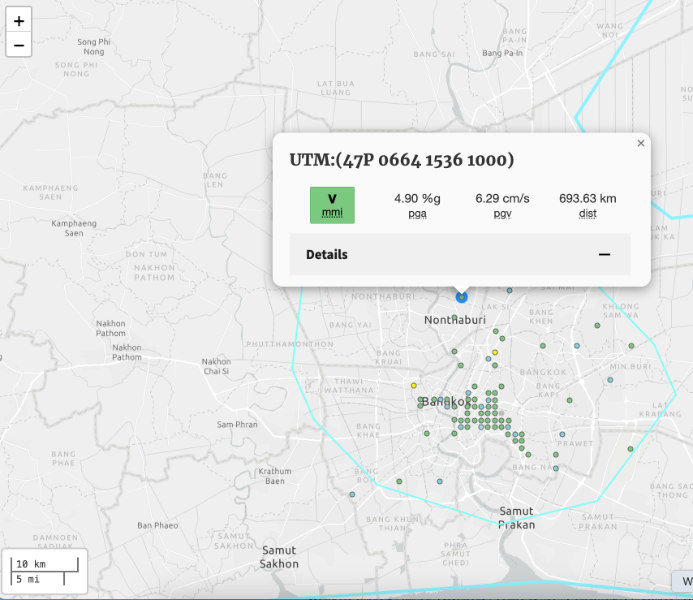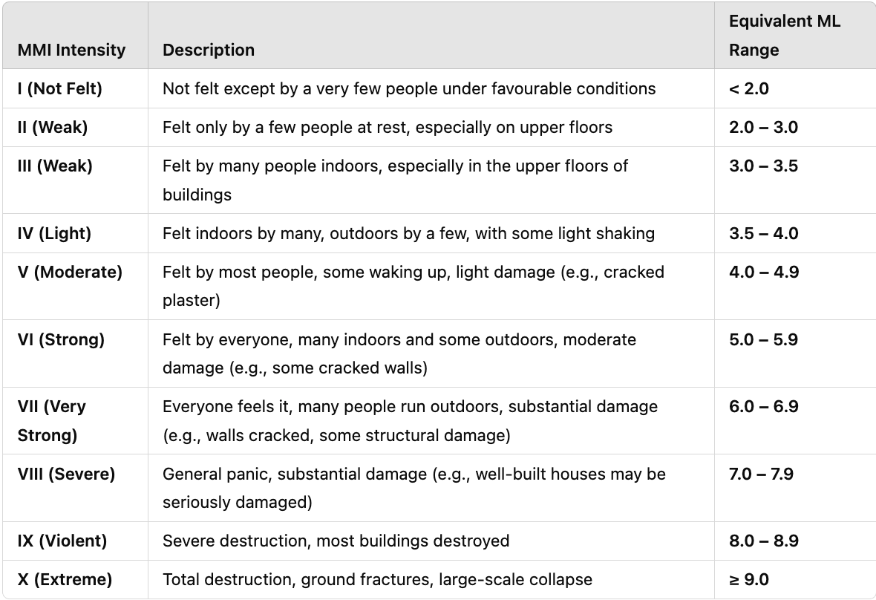-
Posts
36,533 -
Joined
-
Last visited
-
Days Won
34
Content Type
Events
Forums
Downloads
Quizzes
Gallery
Blogs
Everything posted by richard_smith237
-
Understanding the area is key to understanding the Tsunami risk. This quake clearly presented no risk whatsoever of a Tsunami, anywhere - certainly not the Andaman. However, La Palma (Canary Islands) could cause devastation across the whole Eastern seaboard of the Americas (the Netflix series was exaggerated - but based on a geological reality).
-
I too watched videos (re-posted by people in the UK) of the roads getting ripped up etc and building swaying and falling.... Some of these videos clearly showed Japanese numberplate vehicles, and imagery from other disaster sites mixed in with the worst of the images from Bangkok. Those who make such media are not invested in truth, they are interested in clicks and created drama - personally, for anyone who deliberately 'creates' such false media there should be penalties, as this creates further hysteria. News outlets themselves are just as bad - my Wife and I received well wishing messages from all of the world - it was as if the whole of Bangkok had been flattened - the media only interested in reporting the most extreme of damage, rather than a balanced overview. If anyone ever watched 'Drop the Dead Donkey' from the UK years ago - this is exactly what happens.
-
I don't think they are able or medically qualified to diagnose what the true medical condition is so to administer medication correctly would be at best a guess an unwise Agreed... legal liability being more of a concern than life itself. If airlines were able to carry some basics: - Epi-Pens - Heparin (Clexane) - Nitroglycerin spray All which which could life saving, but as you point out, there is an element of risk. Standing by an doing nothing has become the legal status-quo.
-
Minor aftershocks are fuelling mass hysteria after Friday's event, understandably creating widespread fear. If you're in a tall building and feel a minor aftershock, it’s natural to be more concerned - I'd poop it a fair bit even knowing what I know !!!... Realistically, the energy build-up along the Sagaing Fault has been released. I can't foresee another major quake for a long time. Any aftershocks are just: Re-adjustments of Faults: The fault line where the plates or rocks slipped has become destabilised. Elastic Rebound: Tectonic plates that had been "stuck" at fault lines, after excessive elastic movement, are continuing to adjust to their new positions, causing further tremors. Cascading Faults: A rupture from the main quake can trigger nearby faults, leading to aftershocks. In short, the Earth is simply finding its balance. It’s extremely unlikely any aftershock will be stronger than the main quake, unless in a very specific geological setting, such as complex faulting or nearby fault lines being triggered. The Sagaing Fault doesn’t fit this structure. However, in 1960, a major 8.0 quake in Chile triggered a 9.5 quake after a larger rupture occurred.
-
Ironically, you managed to grace this forum with your presence at the exact same time to reply! How delightful it is when those who criticise others for spending too much time on forums are themselves such frequent participants. Now, let's address the numbers: My post count averages around five per day. Yours? Roughly 2.5. Let’s be honest here - it doesn’t exactly take a marathon to fire off two or five posts a day. Or does each of your posts take so long to craft that those 2.5 daily contributions require a significant portion of your day? I’ll admit it - I do enjoy my time on this forum. The discussions are more engaging than the mind-numbing drivel of TV, YouTube, or TikTok. So, in that sense, your critique falls flat. It’s a weak attempt at retaliation, clearly born from the sting of unintelligent comments being exposed for what they are. But let’s refocus on the real issue: Tofu Buildings. It hardly matters who first coined the term - what’s more important is that none of Bangkok’s occupied buildings collapsed, and there was no widespread loss of life. That’s a testament to the quality of construction, not the tofu-like fragility you’re so eager to imply. The term was only ever used here as a cheap shot to degrade Thai standards. Now, let’s put things into perspective. Had a seismic event of similar localised magnitude struck a city like London or Paris the damage might have been far worse. We can’t know for sure. What we do know, however, is that a major event in Bangkok didn’t result in a massive loss of life, unlike what we’ve seen in other places under comparable circumstances.
-

Flood of Crack Reports Follows Bangkok Earthquake
richard_smith237 replied to webfact's topic in Bangkok News
Structural damage is undoubtedly a significant concern... .... But it’s important to first acknowledge the positive outcome: no occupied buildings collapsed, and there was no 'major' city wide loss of life (other than the tragic losses at the collapsed construction site of course). Given the considerable force of the event, with some estimates suggesting a local magnitude reaching an MMI (Modified Mercalli Intensity) value of VI, which corresponds to an approximate magnitude of 6.0 on the Richter scale, the outcome could have been far worse. In this context, Bangkok performed impressively well, especially considering how different the news could have been over the past few days. However, the real concern now lies in the 'follow-on impact' - the structural integrity of buildings and the public's trust in a regime and culture that has a recent history of corruption, which is a justified worry. People are understandably anxious about the quality of safety in a system that has previously been called into question. Buildings that have sustained major structural damage are, without a doubt, now uninhabitable. On the other hand, those with more minor damage can be repaired, although this requires thorough evaluation by trusted experts. Then, we have the widespread cosmetic damage, which many are mistakenly conflating with structural damage. While this type of damage can be fixed relatively easily, it obviously costly. From a scientific perspective, the 'swaying' of taller buildings was largely due to the amplified effects of the lake bed beneath the city. When seismic shear waves, which are particularly destructive, propagate through soft subsurface strata, their impact can become amplified in taller buildings. The resonance of the building's height often aligns with the seismic waves, causing the building to sway more intensely. This is further exacerbated by the 'swing effect,' where the building's own motion becomes amplified by the seismic forces. In contrast, while our house in central Bangkok did experience considerable shaking, with fixtures swaying and some items falling off shelves, the structure itself remained completely intact, with no signs of damage at all. It’s likely that low-rise buildings and houses experienced minimal, if any, damage. Perhaps the most noticeable issues would be minor cracks in plastering or rendering, which are typical after an event like this (its even typical when there is a construction project nearby !!) In essence, this was a quake that primarily impacted buildings of a certain height. The critical factors were the amplification effects of the soft soil beneath the city and the resonance of buildings with the seismic waves. And now, this event has given rise to a number of 'Thai bashers' - individuals who simply cannot resist the urge to criticise. However, their sociophonetic patterns betray their own fundamentally flawed standards of education. These individuals tend to project their biases, revealing a lack of understanding of the fundamental principles of the subject matter they are tripping over. -

Flood of Crack Reports Follows Bangkok Earthquake
richard_smith237 replied to webfact's topic in Bangkok News
Its a different substrata... This may help explain why for you - Simplistically put, the quake was magnified in Bangkok due to its 'softer younger formations and basin setting' - its not abnormal, lots of other major cities are build on a similar geological setting. -
Agreed & Agreed !!... plenty of comments thus far highlight a degree of jadedness in areas of high tourist footfall where a dual-coincidence of impolite, drunk and disrespectful foreigners combines with jaded Thai's who may not even be from the area resulting in a rather predicable less than pleasant out come - this develops a 'stigma' that is not really conducive to positivity. Mean while... when stepping beyond the 'critical mass' of foreigner population a pleasant equilibrium of normalcy is once again experience. I find Bangkok pleasant because people people here are just 'normal' - most foreigners here are normal, many working etc, most Thai's are too - everyone somewhat indifferent towards each other yet respectful of each other - it just feels like normal life and I enjoy that. I've been to area's well outside of the area's where foreigners are an 'every day observation' and of course, we (foreginers) are a curiosity - being followed around a supermarket by kids giggling and saying 'farang' is cute, but its not normal life - the friendly interactions with locals is highly endearing, but again - this is too far from 'normal life' for me. The spectrum of interaction and experiences in Thailand is very wide and far reaching - there is no 'one Thailand' i.e. an area that is more Thailand than any other - I read this comment a lot "That's not real Thailand"... But it is... Thailand just exists on this huge spectrum that gives many of us different experiences.
-
This is true... Seismologists sometimes call this problem the "Mexico City Effect" and Bangkok is often used as another example in modern textbooks because the physics are almost the same . As a comparison this what the substrata of major Thai cities is made up of: Bangkok: Age of Sediment: Holocene (up to 10,000 years old) Characteristics: Soft clay, young alluvial deposits, thick layers (over 100 meters) Stability: Low (high seismic amplification) Pattaya: Age of Rocks: Mesozoic (65–250 million years old) Characteristics: Sandstone, siltstone, shale, crystalline basement rocks, igneous intrusions Stability: Moderate (more stable than Bangkok) Kanchanaburi: Age of Rocks: Paleozoic to Mesozoic (250–540 million years old) Characteristics: Limestone, sandstone, shale, igneous and metamorphic rocks Stability: High (geologically stable) Hua Hin: Age of Rocks: Paleozoic to Mesozoic (65–540 million years old) Characteristics: Sandstone, limestone, granite intrusions Stability: High (less risk of seismic amplification) Khon Kaen: Age of Rocks: Mesozoic (65–250 million years old) Characteristics: Sandstone, shale, siltstone (Khorat Plateau) Stability: Moderate (stable foundation compared to Bangkok) Chiang Mai: Age of Rocks: Paleozoic to Mesozoic (65–540 million years old) Characteristics: Igneous, metamorphic, and sedimentary rocks, including granite, schist, and limestone Stability: High (rugged, mountainous terrain with hard rock base) To avoid any comments that there is blame against Thailand that its capital was 'built' on a poor geological setting' consider ancient settlement theory, access to shipping, lowest bridging points etc... and the fact that at the time little was known of quakes or the area's geological setting. There are plenty of other major cities around the world are that at similar or greater 'amplification risk' from an earthquake due to their geological settings. Los Angeles, USA: Located on the Los Angeles Basin (soft alluvial sediments); ~50 km from the Pacific-North American Plate boundary (San Andreas Fault). Salt Lake City, USA: Situated on soft lake bed sediments from ancient Lake Bonneville; ~400 km from the Intermountain Seismic Belt (within the North American Plate). Seattle, USA: Built on the Seattle Basin (soft alluvial and sedimentary layers); ~100 km from the Juan de Fuca-North American Plate boundary (Cascadia Subduction Zone). Santiago, Chile: Located in the Santiago Basin (soft sedimentary deposits); ~100 km from the Nazca-South American Plate boundary. Quito, Ecuador: Built on soft volcanic ash deposits and sedimentary basins; ~200 km from the Nazca-South American Plate boundary. Athens, Greece: Built on soft alluvial deposits in some areas; ~100 km from the Hellenic Arc (African-Eurasian Plate) boundary. Istanbul, Turkey: Partly located on soft, young sediments near the Sea of Marmara; ~20 km from the North Anatolian Fault (Eurasian-Anatolian Plate boundary). Kathmandu, Nepal: Situated in the Kathmandu Valley (soft ancient lake sediments); ~50 km from the Indian-Eurasian Plate boundary (Himalayan Frontal Thrust). Tehran, Iran: Built on alluvial deposits and loose sediments from nearby mountains; ~100 km from the Arabian-Eurasian Plate boundary (Zagros Fold and Thrust Belt). Tokyo, Japan: Located in the Kanto Basin (soft sedimentary layers); ~100 km from the Pacific-Eurasian-Philippine Sea Plate junction. Taipei, Taiwan: Built on the Taipei Basin (thick sedimentary deposits); ~50 km from the Eurasian-Philippine Sea Plate boundary. Shanghai, China: Located on soft deltaic sediments from the Yangtze River; ~1,200 km from the Pacific-Eurasian Plate boundary (Japan Trench). Wellington, New Zealand: Built on soft alluvial sediments and reclaimed land; ~30 km from the Pacific-Australian Plate boundary (Wellington Fault). Cairo, Egypt: Partly built on Nile Delta sediments (soft, unconsolidated deposits); ~1,000 km from the African-Arabian Plate boundary (Red Sea Rift).
-
Agreed... for those with a healthy sense of balance the positives in Thailand are all around us in abundance, sitting right alongside those the aspects that are not so positive, the negatives as they may be called. Being able to recognise both and discus openly shows a healthy sense of balance by not being overtly bias towards or against but simply having the ability to make observations. Thailand for the vast majority is clearly a net positive and thats why we are here. I too am often left pleasantly surprised when encountering simple and fast responses to situations I might have otherwise expected to include an unnecessary or beurocratic complexity.
-

Ive prepaid a hotel close to the building that collapsed.
richard_smith237 replied to advancebooking's topic in Bangkok
The building under construction that collapsed did not collapse due to the 'after-shock' it collapsed due to the Earthquake. No completed structures collapsed. This earthquake was as bad as it can get in Thailand.... The previous largest quake on the same plate boundary was in 1912 with a 7.9 Mw Richter Scale. The largest quake to epicentre in Thailand is 6.1 Mw in Chiang Rai. With regards to 'further after-shocks'... this is unlikely on a large scale as this fault / plate boundary already released a significant amount of energy / stress. In short - the only thing to worry about is the excessive traffic in that area as they'll still be 'clearing the debris' so I imagine there will be a lot of lorry traffic. -

Cellphone network recommendations
richard_smith237 replied to BexMan's topic in Mobile Devices and Apps
Being overseas of a significant amount of next year I'll be looking to cut down to a minimal usage, while still maintaining the same number in which I can receive 'Wifi' roaming calls (i.e. with the existing True e-Sim) and also use as regular service when here. At the same time using local SIM's for the area's I will be in. Thus: being able to switch my number over to a yearly service would be idea. (apologies if this is highjacking the thread) -------- With regards to the Op: My Wife uses DTAC, I use True - there really isn't much difference in service - coverage or quality from what we can tell. -
Wife is the same... comes down to personal preference of course.
-

Cellphone network recommendations
richard_smith237 replied to BexMan's topic in Mobile Devices and Apps
Piggy backing on this... Do such sims work for Data Roaming and WiFi calling when overseas... And... can our existing number be kept ? -
I don't know about you, but I hate 'searching' for stuff on the phone... I'll always prefer to use the laptop... from Google maps, to Agoda / Booking etc... To this forum... I had typing or looking for stuff on the phone and find the laptop much easier. Plus - the lazada App itself is so 'noisy and cluttered'....
-
You're so hi-so, I'm jealous I wonder if he threatens to 'slap her' if she doesn't agree with everything he says....
-
Why don't you take your own advice? It’s almost impressive how clueless SF is - spouting off about getting off the keyboard and living life while hunched over his own, hammering the same tired nonsense, not just once but twice. Irony really isn't his strong suit, is it? Honestly, if there was ever a poster child for the saying, "Better to remain silent and be thought a fool than to speak and remove all doubt," SF just nailed it. His contributions to the thread are living, breathing proof that some people really should stick to silence. And just when you think it can’t get any more pathetic, he starts bragging about beating up kids at school - as if that somehow elevates his status, when in reality it just makes him look even more unhinged. Throw in the threats towards strangers on an anonymous forum, and you’ve got a full-blown circus of insecurity and misplaced bravado. Well done, SF. You've managed to hijack a normal thread and turn it into your own personal playground of bitterness. Brilliant stuff....
-
Quite hypocritical don't you think, considering your content has by far been the nastiest in this thread.... Those in glass houses... You first suggested the Op is a stinky old foreigner and that 'she's letting him know'..... You then threatened the guy who lightly retaliated.... Take a look in the mirror
-
100% this - there really is nothing more to it.... and... IF you have spoken Thai, the its just a very simple habit the other person has evolved when speaking with a foreigner in an area of high tourist footfall. Consider it respectful - the kind of female vendor who speaks to a foreigner in such a manner is giving an example of the 'correct pronunciation', even if you have pronounced your Thai correctly - its just habit and shows good intentions - nothing more than that.
-
Flippin ek... you went from zero to incendiary there threading another forum member.... A tat over the top and unhinged don't you think ?
-
Yep... I've had the same thing... its a PITA. It used to send an OTP to the phone - the thing is, I used my Wife's number as she deals with the phone calls when something is being delivered... so when it sent the OTP I'd have to call her to get the number !! (if she was out etc).
-
That must have been a relief... some of the photos doing the rounds show structural damage. I'm not sure how they can retroactively repair such damage or if the building has to be condemned. Most of the photos I have seen are of superficial damage of non-load bearing walls, it looks horrific, as per the video above (from Safety First) - I don't think any of that damage is structural and can be repaired, though the costs of repair will be devastating for many.
-

When a 7.7 Magnitude quake hit Myanmar yesterday - in pictures
richard_smith237 replied to CharlieH's topic in Thailand News
Also note the values are in MMI (Modified Mercalli Intensity)..... Bangkok ranged between IV, V and VI Equivalent to ML: 3.5 – 4.0 / ML: 4.0 – 4.9 / ML: 5.0 – 5.9 Behaviourally (i.e. based on observation) the quake can be measured up to VII, (Very Strong): Equivalent ML: 6.0 – 6.9 Everyone feels it, many people run outdoors, substantial damage (e.g., walls cracked, some structural damage). This is higher than the calculated ML equivalency posted yesterday (between 4 and 5 ML) but corresponds with some of the structural building damage we are seeing in photos yesterday and today.










